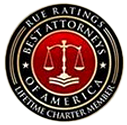The four elements of negligence are what a plaintiff must prove to recover personal injury compensation in Pennsylvania. As the plaintiff, you must prove all four of the elements, and you have the burden of proof.
Gibbons & Crichton, Personal Injury & Accident Lawyers explain the four elements of negligence in Pennsylvania and how to prove your case. Get an individual consultation with our Philadelphia personal injury lawyers to review your negligence claim.
What Are the Four Elements of Negligence in Pennsylvania?
The four elements of negligence in Pennsylvania are:
- Duty of care: The legal requirement to act safely.
- Breach of duty of care: Failing to meet the duty of care – acting negligently.
- Proximate cause: The person’s negligence causing harm.
- Damages: The harm that results to the victim – economic and non-economic.
What is a Duty of Care?
A duty of care is the legal obligation that someone in society has towards others. It is a duty that requires someone to act, or to refrain from acting, in a way that creates an unreasonable risk of harm.
Examples:
- Motor vehicles: A motor vehicle driver has to drive at a safe speed, given the traffic and road conditions.
- Restaurant: A restaurant has to keep food safe and free from contamination.
- Stores: Store owners must keep their property free of hazards for customers and patrons.
- Healthcare: Medical professionals must perform their duties with skill and attention.
- Products: Designers and manufacturers have to make products safe for their intended use.
A duty of care exists in many situations. However, there are some situations where a person doesn’t have a duty of care. There must be a relationship to prompt a duty.
The four elements of negligence in Pennsylvania start with examining whether the defendant owed a duty of care. Once the defendant’s duty is established, the next question is whether the defendant breached their duty.
See Grove v. Port Auth. of Allegheny Cnty., 218 A.3d 877 (Pa. 2019).
What Is a Breach of the Duty of Care?
A breach of duty is a failure to meet the duty of care in a particular situation. It is acting in a way that a reasonable person wouldn’t, or failing to act how a reasonable person would. The breach creates an unreasonable risk of harm.
The law doesn’t detail what amounts to a breach of duty in every situation. The law can’t possibly anticipate every situation. What amounts to a breach of duty varies from case to case depending on the facts and the degree of danger. The law leaves it to the jury to decide whether the defendant breached the duty of care.
Examples:
- Motor vehicles: A driver was speeding. They traveled too fast for slippery roads and traffic.
- Restaurant: A restaurant served old food that hadn’t been stored properly.
- Stores: Employees mopped the floor and failed to place warning signs of a wet floor.
- Healthcare: The doctor failed to run a test that should have been run based on symptoms.
- Products: The company failed to notice a manufacturing flaw.
The duty of care extends to reasonably foreseeable risks. A person isn’t required to take every possible step to avoid harm. They must do what’s reasonable.
How to prove a breach of duty for negligence?
Proving a breach of duty is a two-part task. First, you must show what the person did or failed to do. The actions of the defense may be in dispute, so you need factual witnesses. Second, you must show that these actions were unreasonable. You may show that they violated a law, for example. Alternatively, you may present an expert to explain how their actions created an unreasonable risk of harm. You may argue that a reasonable person would have acted differently.
What is the Proximate Cause?
Proximate cause is when a person’s negligence is the cause of an accident or injury. It is the causal connection between the breach of the duty of care and the plaintiff’s injury.
To prove proximate cause, the plaintiff shows that the defendant’s act or lack of action was a substantial factor in bringing about the harm to the plaintiff. There is a nexus between the defendant’s actions and the victim’s harm such that it is appropriate to hold the defendant liable. Powell v. Drumheller, 539 Pa. 484 (1995).
Examples:
- Motor vehicles: The speeding driver caused an accident.
- Restaurant: Someone who ate contaminated food got sick.
- Stores: A customer slipped on the slippery floor, suffering a broken arm and a brain injury.
- Healthcare: The patient’s cancer wasn’t diagnosed for several months.
- Products: A malfunctioning product caused physical injury.
Acting negligently, by itself, doesn’t make a person liable for harm. It’s when negligence is the cause of harm that the defense is legally liable for damages.
For example, a driver is speeding and weaving in and out of traffic. However, there is no accident, and no one is harmed. The driver may deserve a ticket, but the other drivers around them don’t have a negligence claim. On the other hand, if a driver is speeding and weaving out of traffic, and rear-end another vehicle, the driver is responsible for negligence.
See Repa v. Napierkowski, 1:19-CV-00101-RAL (W.D. Pa. Aug. 10, 2022).
What Are Damages in a Personal Injury Claim?
Damages in a personal injury claim are the compensable losses that the victim sustains.
Compensable damages generally include economic losses, like medical bills, and non-economic losses, like pain and suffering.
Damages depend on two factors. First, damages may vary based on the type of case. For example, there may be limits if the defendant is a unit of the government. Additionally, there are standards for when punitive damages are allowed and when they are capped.
Second, damages in a personal injury claim are specific to the defendant. The defendant may claim their unique damages. They present evidence of their losses and harms.
Got Hurt? Get Gibbons!
To recover personal injury compensation, you must prove the four elements of negligence in Pennsylvania. When you hire Gibbons & Crichton, Personal Injury & Accident Lawyers, we can investigate and prove your case for compensation. For a free consultation, and to start your case today, call 215-274-0173 or message us now.














